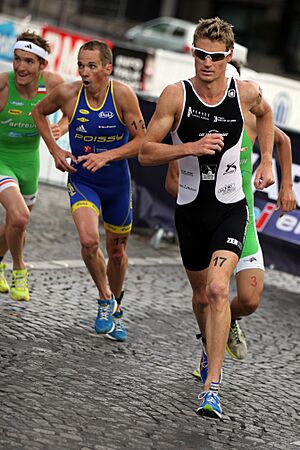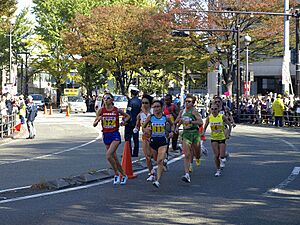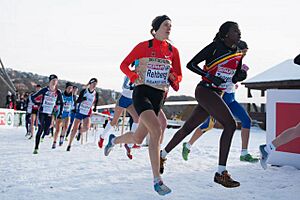Long-distance running facts for kids
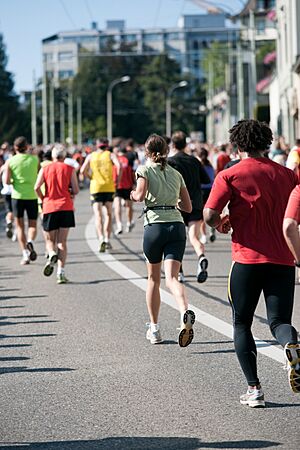
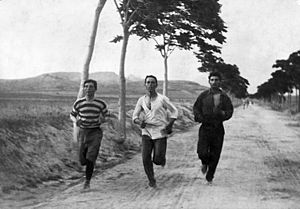
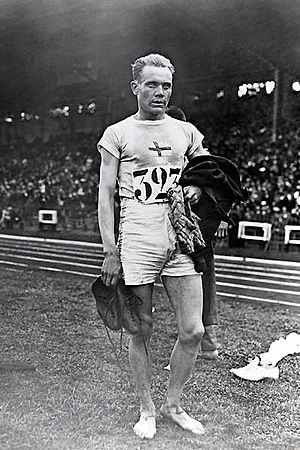
Long-distance running, also called endurance running, is a type of running that covers distances of at least 3 kilometers (about 1.86 miles). It mostly uses your body's aerobic system, meaning it needs a lot of oxygen. This kind of running requires great stamina and mental strength.
When you run long distances, your body uses two main ways to get energy. The most common is aerobic respiration. This happens when there's enough oxygen, and your body uses it to create energy for your muscles. The other way is anaerobic respiration. This happens when your body doesn't get enough oxygen, often when you're pushing hard at the end of a race to speed up. Both types of energy use are important for endurance runners, even though they are very different.
Humans are naturally good at running long distances, especially compared to other mammals like primates. Some animals, like ungulates (hoofed animals) that migrate, and certain meat-eaters like bears, dogs, wolves, and hyenas, also have good endurance for running.
Today, people run long distances for many reasons. It can be for physical exercise, just for fun, as a way to travel, or as a competitive sport. Some people run for work or for cultural reasons. Long-distance running is also great for keeping your heart and blood vessels healthy.
Endurance running is often part of military training. Some cultures, like the Hopi and Tarahumara people, have traditions and ceremonies that involve long-distance running.
In the sport of athletics, long-distance events are races that are 3 kilometers (1.86 miles) or longer. The three main types are track running (on special tracks), road running (on roads), and cross country running (on natural terrain).
Contents
History of Long-Distance Running
Running for Hunting
Long ago, people used long-distance running as a way to hunt. Scientists have studied modern hunter-gatherer groups, like the San in the Kalahari Desert, American Indians, and Aboriginal Australians. These groups would run at a slow, steady pace for hours, or even days, to chase animals until they were too tired and hot to run anymore. The animals would run in short bursts, but they needed to stop to cool down. Eventually, they would collapse from exhaustion and heat. Some evidence from a 1.5-million-year-old skeleton of a 12-year-old boy suggests that early humans ate more meat and hunted by running down animals.
Running as Messengers
As societies grew, long-distance running found new uses beyond hunting. It became important for religious ceremonies, sending messages for military or political reasons, and as a sport.
Early records from Sumer mention running messengers called lasimu. These were military men and king's officials who ran to deliver documents across the kingdom. Ancient Greece was also famous for its running messengers, known as hemerodromoi, meaning "day runners".
One of the most famous running messengers is Pheidippides. Legend says he ran from Marathon to Athens to announce that the Greeks had won the Battle of Marathon against the Persians in 490 B.C. He supposedly collapsed and died after delivering the message, "We won!" While historians debate the exact details of this story, the modern marathon running event (26.2 miles or 42.195 km) is based on this famous legend.
Running as a Competition
Today, long-distance track races usually range from 3,000 meters (1.87 miles) to 10,000 meters (6.2 miles). Cross country races are typically 5 to 12 km (3 to 7.5 miles). Road races can be much longer, sometimes over 100 km (62 miles). In U.S. college cross-country, men usually race 8,000 or 10,000 meters, while women race 6,000 meters.
The Summer Olympics features four long-distance running events:
- The 3000 metres steeplechase (which includes jumping over barriers and a water pit).
- The 5000 metres.
- The 10,000 metres.
- The marathon (42.195 kilometers, or 26 miles and 385 yards).
How Your Body Runs Long Distances
Humans are considered among the best distance runners compared to other animals. While some animals are faster over short distances, humans have more endurance. Unlike other primates that walk on four legs or climb trees, the human body started walking and running upright about 2-3 million years ago.
Your body can handle long-distance running thanks to these features:
- Bone and Muscle Structure: Humans stand upright, so our center of mass is directly over our legs. This means our leg and pelvis bones and muscles are built differently than those of four-legged animals, helping us run efficiently.
- Cooling Down: Humans can cool their bodies by sweating through their skin. This is a big advantage over animals that cool down by panting through their mouths or noses. Sweating allows for a larger area to cool down and doesn't depend on how fast you breathe.
- Longer Tendons: Humans have longer, more spring-like tendons compared to our four-legged relatives. These tendons store and release energy, making running on flat ground more efficient.
It's interesting to note that walking uses about half the energy that running does.
Key Factors for Endurance
Aerobic Capacity (VO2Max)
Your aerobic capacity, or VO2Max, is how well your body can take in and use oxygen during intense exercise. Long-distance runners typically use about 75–85% of their maximum aerobic capacity during a race. Elite long-distance runners often have larger hearts and slower resting heart rates. This allows their hearts to pump more blood with each beat, delivering more oxygen to their muscles.
Lactate Threshold
Your lactate threshold is the point during exercise when your body starts producing more lactic acid than it can clear away. This is seen as the switch from mostly aerobic (with oxygen) to anaerobic (without enough oxygen) energy use. Training at this threshold helps your body become better at clearing lactate and using it for fuel.
Fuel for Your Muscles
To keep running at a high intensity, marathon runners need enough glycogen stored in their muscles and liver. Glycogen is like your body's stored energy. If you start a race with low glycogen, you might run out of energy too soon. Free Fatty Acids can also be used for energy, which helps save your glycogen stores for later in the race. Many long-distance runners practice carbohydrate loading before a race. This means eating a lot of carbohydrates to build up their glycogen stores.
Staying Cool and Hydrated
Keeping your body temperature normal is super important for marathon runners. If your body gets too hot, it can lead to hyperthermia. To cool down, your body sweats, which means you lose fluids. You need to drink fluids to replace what you lose. While it's hard to drink enough during a race to replace all the sweat, drinking some fluids helps keep your body from overheating. Hot weather can make it even harder to stay cool.
Running at High Altitude
Since the late 1980s, runners from Kenya, Morocco, and Ethiopia have been very successful in international long-distance races. Many of these runners come from high-altitude areas in the Great Rift Valley. Training at high altitude can help your body produce more red blood cells, which means your blood can carry more oxygen to your muscles. Besides altitude, a strong culture of hard work, teamwork, and good training programs also helps these runners succeed.
Health Benefits and Risks
Long-distance running is generally very good for your health. It can make your bones stronger and help lower your cholesterol.
However, too much running can sometimes have downsides. Older male runners (45-55) who run more than 40 miles (64 km) a week might have slightly lower testosterone levels, though usually still in a normal range. Running a marathon can temporarily lower testosterone and increase stress hormones. Some studies suggest that very elite, lifelong endurance athletes might have more heart scarring, but more research is needed to confirm this. Some studies also suggest that running more than 20 miles (32 km) a week might not offer extra benefits for overall lifespan compared to running less, though other large studies show that any increase in exercise helps you live longer.
Elite-level long-distance running is linked to a higher risk of knee osteoarthritis (a joint condition) later in life, compared to people who don't run.
The use of special shoe inserts has been debated. While memory foam inserts might feel comfy, they could weaken foot muscles over time. Fancy running shoes or even minimalist shoes don't necessarily prevent injuries. Instead, comfortable shoes and a natural running style are often safer.
Long-Distance Running as a Sport
Many sports, like association football (soccer) and rugby league, involve a lot of running for long periods. But continuous endurance running is mainly found in racing sports. Most of these are individual sports, but there are also team and relay events.
The most popular long-distance running sports are part of athletics. In these competitions, runners race on specific courses, and the fastest person to finish wins. The main types are long-distance track running, road running, and cross-country running. Other less common types include fell running, trail running, mountain running, and tower running. These combine distance with challenging uphill or downhill sections.
Many multisport races also include endurance running. For example, a Triathlon involves swimming, cycling, and running. The running part can be from 5 km (3.1 miles) up to a full marathon (42.195 km). A duathlon combines cycling and distance running. Even the modern pentathlon used to have a long run, but now it's split into three shorter 1 km (0.6 mile) runs.
Navigation sports like foot orienteering and rogaining can also involve periods of endurance running, depending on the rules and terrain. Some adventure races combine navigation skills with endurance running.
Types of Running Competitions
Track Running

Long-distance track running events are held on special tracks, usually oval-shaped, which allow athletes to cover long distances in a small area. Early tracks were often just flattened earth or grass. In the 20th century, tracks became more advanced. They were standardized to 400 meters (about a quarter-mile) and made of synthetic materials like asphalt and rubber starting in the mid-1960s. The standard long-distance track events, the 5000 metres and 10,000 metres, were first introduced at the 1912 Stockholm Olympics.
- The 3000 metres steeplechase is a race where runners not only run but also jump over barriers and a water pit. It's considered both a hurdling and a long-distance event. The men's barriers are 914 mm (about 3 feet) high, and the women's are 762 mm (about 2.5 feet) high.
* The men's world record is 7:53.63, set by Saif Saaeed Shaheen (Qatar) in 2004. * The women's world record is 8:44.32, set by Beatrice Chepkoech (Kenya) in 2018.
- The 5000 metres is a top event that needs good strategy and excellent aerobic fitness. Training for this race can involve running 60 to 200 km (37 to 124 miles) a week, though training plans vary a lot. It's often a popular race for new runners.
* The men's world record is 12:35.36, set by Joshua Cheptegei (Uganda) in 2020. * The women's world record is 14:00.21, set by Gudaf Tsegay (Ethiopia) in 2023.
- The 10,000 metres is the longest standard track event. Many runners who do this race also compete in road races and cross country running events.
* The men's world record is 26:11.00, set by Joshua Cheptegei (Uganda) in 2020. * The women's world record is 29:01.03, set by Letesenbet Gidey (Ethiopia) in 2021.
- The One hour run is a rare endurance race where the goal is to run as far as possible in one hour.
- The 20,000 metres is also rarely run as a standalone event. Most world records for this distance have been set during a one-hour run race.
Road Running
Long-distance road running races are mostly held on paved roads, but big events often finish on a track inside a stadium. Besides being a popular recreational sport for many, elite marathon races are some of the most watched events in athletics. Road races can be almost any distance, but the most common and well-known are the marathon, half marathon, and 10 km run.
Road running started with "footmen" in the 18th century. These servants would run alongside noble carriages or run errands over long distances for their masters. Over time, rich people started betting on their footmen in races. The sport became professional, with footmen training specifically for these gambling events. In the late 19th century, amateur sports became more popular, and the professional gambling model faded.
The 1896 Summer Olympics saw the first modern marathon. This event led to the growth of road running, with annual public races like the Boston Marathon (first held in 1897) and the Lake Biwa Marathon in Japan (started in the 1940s). The "running boom" of the 1970s in the United States made road running a common hobby and increased its popularity for elite athletes.
The marathon is the only road running event at the World Athletics Championships and the Summer Olympics. There's also the World Athletics Half Marathon Championships held every two years. The World Marathon Majors series includes the six most famous marathons for elite runners: Berlin, Boston, Chicago, London, Tokyo, and New York City.
Ekiden races, which started in Japan, are a type of relay race for marathons, unlike most road running which is individual.
Cross Country Running
Cross-country running is the most natural type of long-distance running in athletics. Races happen outdoors on surfaces like grass, forest trails, dirt, or mountains. Unlike the flat courses of track and road races, cross country often includes obstacles like muddy sections, logs, and hills. This means the weather can greatly affect race conditions.
Cross country is both an individual and a team sport. Runners are judged individually, and teams score points based on their runners' finishes. Races are typically 4 km (2.5 miles) or longer and are usually held in autumn and winter. Top cross-country athletes often also compete in long-distance track and road events.
The sport's history is linked to a game called "paper chase" or "hare and hounds," where runners would chase a leader who left a trail of paper. The Crick Run in England in 1838 was the first organized cross-country competition. The sport grew popular in British and American schools in the 19th century. This led to the first International Cross Country Championships in 1903. The annual World Athletics Cross Country Championships started in 1973 and is still the highest level of competition for the sport. There are also continental championships in Africa, Asia, Europe, Oceania, and the Americas. The sport remains popular in schools, especially in the UK and USA.
While cross country competitions are no longer held at the Olympics (they were part of the athletics program from 1912 to 1924), they have been one of the events in the modern pentathlon since the 1912 Summer Olympics.
Fell running, trail running, and mountain running are similar to traditional cross country, but they add the extra challenge of significant uphill and/or downhill sections.
Adventure Running
Adventure running is a general term for any long-distance running in a natural setting, no matter the surface. It can involve crossing rivers, scrambling (climbing over rocks), running in snow, or dealing with very hot or cold temperatures and high altitudes. It can be competitive or just for fun, for individuals or groups. Because of this, courses are often set in beautiful places and have obstacles designed to give runners a sense of accomplishment. It's similar to the running parts of adventure racing.
Ultra-Long Distance: Extreme Events
Ultramarathons and Multiday Races
There are many events and records for long-distance running that go beyond typical track and field events. These include ultramarathons (races longer than a marathon), multiday races, and long-distance races in extreme conditions or covering hundreds or thousands of miles.
Beyond these regular events, there are also unique achievements by individuals who have run across or around continents (like America or Australia) or even around the world.
See Also
- Fastpacking
- Middle-distance running
- Neurobiological effects of physical exercise
- Paceband
- Rarámuri people
- Running economy
- VO2max


